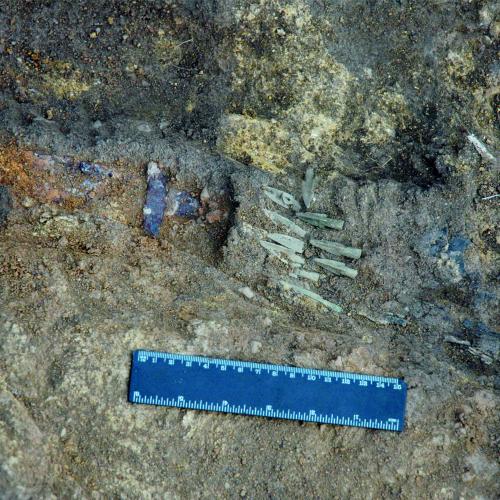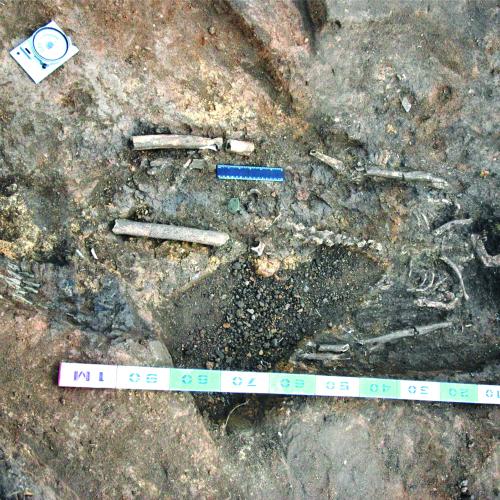Раскопки кургана проводились под руководством Д.Г. Здановича в 2016 году. Предположение о наличии объекта было высказано Г.Б. Здановичем, благодаря найденным на этом месте в 2005 г. фрагментам археологизированного дерева в выбросе из нор землероев.
В эпоху бронзы комплекс Синташта IV представлял собой округлую площадку диаметром 7,5-9 м, окруженную слабо заглубленным ровиком-канавкой.
Возникновение комплекса Синташта IV относится к эпохе бронзы. С бронзовым веком связаны развалы двух керамических сосудов черкаскульской культуры (XI-IX вв. до н. э) и, возможно, погребение № 2 (ребенок 12-14 лет) на восточном краю площадки с набором астрагалов мелкого рогатого скота в виде инвентаря и погребение 3 в ровике (остатки частичного трупосожжения подростка или женщины). Судя по всему, останки сжигались в другом месте и были помещены в яму вместе с прокаленным грунтом и угольками. Налицо, таким образом, вторичное использование керамики бронзового века ранними кочевниками раннесарматской эпохи.
Ранний железный век представлен раннесарматскими погребениями № 4 (конец V – первая половина IV веков до н.э.) и № 1 (конец IV- первая половина III вв. до н. э.). В этих захоронениях мужчин-кочевников обнаружены железный кинжал, наборы бронзовых наконечников стрел – втульчатых трехлопастных и со скрытой втулкой, пряжки из металла и кости, лепные сосуды.
Погребение 4 совершено в крупной грунтовой яме. Погребение ограблено в древности. Захоронение представляет интерес с точки зрения ритуала ограбления. Часть костей была изъята, другая часть намеренно переложена и изменен их порядок положения. Все останки (возможно, за исключением некрупного фрагмента черепной коробки) принадлежат одному индивиду – мужчине в возрасте 30-35 лет.
The Sintashta-4 Burial Complex (S-4)
The Complex was discovered by G.B. Zdanovich in 2007 and excavated in the course of a joint expedition by the Charitable Foundation “Arkaim”, the “Arkaim” Reserve, and Chelyabinsk State University in 2016. The expedition was directed by G.B. Zdanovich while the excavation was supervised by D.G. Zdanovich. The burial complex was virtually invisible on the surface and was identified by wood fragments coming out of animal burrows.
2 periods – The Sintashta-4 Burial Complex functioned in the course of two periods – the Bronze Age (12th-10th centuries BC) and the Early Iron Age
Bronze Age burial
At first, the complex was a circular area 7.5-9 m in diameter, surrounded by a shallow ditch. In the western part of this area, in a shallow ditch, was Burial No. 2, containing a subadult (12-14 years old) accompanied by a set of talus (astragalus) bones of sheep/goat.
Not far from Burial No. 2, in the western part of the shallow ditch, archaeologist discovered a concentration of sherds belonging to two vessels of the Cherkaskul type. Beyond the northeastern edge of the circular area, in a circular ditch, archaeologists found remnants of Burial No. 3, which contained the remains of a partially cremated woman or a child. Apparently, the corpse was burnt in another place and was transported into the pit together with heated soil and charcoal.
Early Iron Age burial
Two burials date to the Early Sarmatian period: Burial No. 4 (end of the 5th -first half of the 4th centuries BC) and Burial No. 1 (end of the 4th – first half of the 3rd centuries BC). Both of the burials are associated with large yet shallow graves. Burial No. 1 (adult male), which was undisturbed, provides us with a complete picture of that period’s burial ritual. Burial No. 4, which was robbed in antiquity, is interesting in the context of studying the ritual of grave robbing. Some of the bones were extracted from the grave while other bones were placed back into the grave out of order. All bones belong to one individual – a man 30-35 years old.
In the graves of the nomads archaeologists found an iron dagger, a set of tri-bladed socketed
bronze arrowheads (with a hidden socket), buckles made of metal and bone, handmade ceramic vessels. The bronze buckle is analogous to the ones found in the Pamir Mountains, which points to the Southern Ural nomads’ long-distance connections. At the same time, archaeologists see the local roots of the Iron Age nomads’ material culture. For instance, Bronze Age ceramics were reused by the later Iron Age populations.

